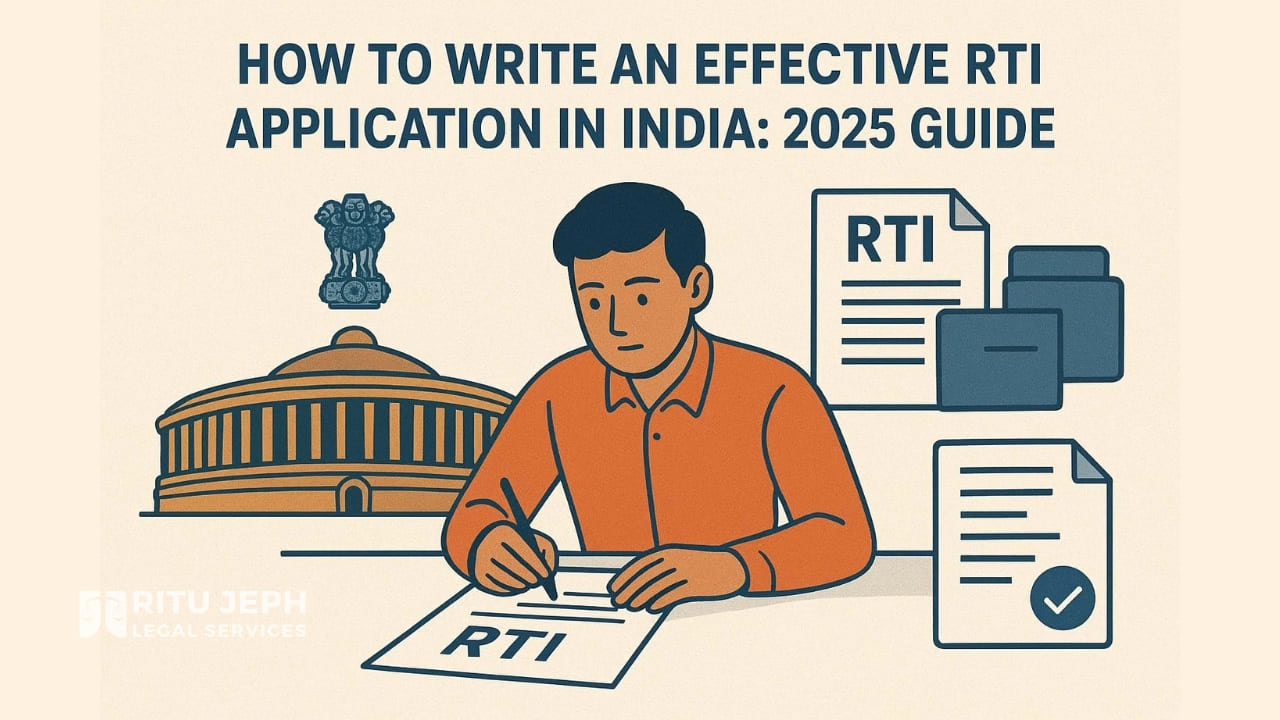Book Appointment Now

How to Write an Effective RTI Application in India: 2025 Guide
Master how to write an effective RTI application in India with a complete step-by-step procedure, including detailed online filing process, tips to prevent refusal, and strategies to ensure timely responses from government departments.
The Right to Information (RTI) Act of 2005 gives every Indian citizen the power to ask for details from government offices. It’s a simple tool to promote openness and hold public bodies accountable. But to make your request work well, you need to know how to craft an effective RTI application in India. A poorly written one can get turned down or delayed. In this guide, we’ll cover the full step-by-step process, tips to avoid refusal, key points to remember, how to send it to the right place, and ways to push for a reply if needed. We’ll also explain how to file an effective RTI application in India online in detail, which is a quick and popular method, especially for central government queries. Plus, we’ll share some lesser-known facts that can make your application stronger.
First, understand what makes an effective RTI application in India. The goal is to ask for facts or records held by public offices, not opinions or reasons. Keep it clear and focused to reduce chances of rejection. Under the RTI Act, offices must reply within 30 days, or 48 hours if it involves life or freedom. But recent changes, like the 2023 Digital Personal Data Protection Act, have made it harder to get personal details unless it’s in the public interest. Filing online has become more popular, with over 50% of central RTIs now digital, reducing delays by 20-30% as per recent reports.
ALSO READ: The Entry of Foreign Law Firms in India: A Game-Changer for the Legal World
Now, let’s go through the step-by-step procedure to file an offline RTI application in India:
- Find the Right Public Office: Start by identifying the government department or body that holds the information. Check their website for the Public Information Officer (PIO) details. Most offices list PIOs online. If unsure, you can send it to a central PIO, and they must forward it within five days. For online filing, confirm if the office supports digital submissions through the relevant portal.
- Gather Your Details: You need your name, address, and contact info. No need to explain why you want the information—that’s your right. But prove you’re an Indian citizen if asked, like with a voter ID copy. For online methods, you’ll need an email and mobile number for registration and OTP verification.
- Draft the Application: Use plain paper, the official form, or the online template. Start with “Under Section 6 of the RTI Act, 2005” to show it’s official. Address it to the PIO with the office name. List your questions numbered and specific. For example, instead of “Tell me about school funds,” ask “Provide the budget details and spending records for ABC School from April 2024 to March 2025.” End with your details and date. Keep it under 500 words if possible. This specificity is key to an effective RTI application in India, as vague ones get rejected.
- Pay the Fee: Attach Rs. 10 as application fee via postal order, demand draft, or cash at the office. No fee for below-poverty-line people. If you want copies, add Rs. 2 per page. For online filing, pay digitally through cards, net banking, UPI, or other electronic methods—no cash needed, and it’s seamless.
- Submit It: You have options here. Send by post, email if the office allows, or in person—use speed post for tracking.
- Follow Up: Note the date you sent it. If no reply in 30 days, it’s a deemed refusal. File a first appeal to the First Appellate Authority (FAA) in the same office within 30 days after the deadline. Online portals let you check status and file appeals directly.
Now, let’s go through the step-by-step procedure to file an Online RTI application in India:
A quicker and more efficient way to file an effective RTI application in India is online. This method is great for avoiding postal delays and getting instant confirmation. Here’s the detailed process for filing an effective RTI application in India online:
- Register on the Portal: Click on “SUBMIT REQUEST” Accept the “GUIDELINES FOR USE OF RTI ONLINE PORTAL” enter your email, mobile number. Verify with the OTP sent to your phone or email.
- Choose the ministry or department from the dropdown list—make sure it’s the right one to avoid transfers. Fill in the form: Enter your personal details like name, address, and gender. In the text box, draft your questions clearly, just like in a paper application.
- Upload any supporting documents if required, such as BPL proof for fee waiver. Pay the fee: Use the integrated payment gateway to pay Rs. 10 online via debit/credit card, internet banking, UPI, or RuPay.
- If you’re BPL, select the option to waive it and upload proof. Submit and track: Review everything, then submit. You’ll get a unique reference number via email and SMS.
- Use this to track the status on the portal under “View Status” anytime. The portal also lets you file appeals online if needed.
- Note: Not all state departments are on online portals yet, so for local issues, you might still need paper filing. Online filing tracks everything digitally, making it easier to prove submission dates.
To make an effective RTI application in India that can’t be easily refused, follow these ways:
- Be very specific: Avoid broad questions like “Tell me about all projects.” Instead, name dates, places, or document types. This forces them to provide exact info and meets legal standards.
- Stick to facts: Don’t ask “why” or “how” questions, as they can be seen as seeking explanations, not records. Focus on “what” is available, like reports or minutes.
- One topic per application: If you have multiple issues, file separate ones. This prevents partial rejections and keeps things organized.
- Use simple words: Write in English, Hindi, or the local language. No fancy terms—just clear sentences to ensure understanding.
Key pointers to keep in mind while writing an effective RTI application in India:
- Don’t threaten or complain in the application; save that for appeals.
- Check if the info is exempt, like national security or trade secrets, under Section 8. Research this to avoid waste.
- If asking about someone else, they get a chance to object if it’s personal—mention public interest if it applies.
- Keep copies of everything you send, including payment proofs. For online, save the confirmation email and screenshots.
ALSO READ: Delhi High Court’s Take on Misuse of Section 498A in Family Disputes
To ensure it reaches the correct department, look up the PIO on the office website or the DoPT portal. If sent wrong, the PIO must transfer it and inform you. For state matters, use state info commissions’ sites. Online portals list departments accurately, reducing errors.
If you don’t get a reply, here’s how to pressure them:
- After 30 days, file a free first appeal to the FAA, explaining the delay. Do this online if possible through the same portal.
- If no luck in another 30-45 days, go to the second appeal at the Central Information Commission (CIC) for central government or State Information Commission (SIC). It’s free and can fine the PIO up to Rs. 25,000 for delays. Hearings can be virtual now.
- Track online if filed digitally. You can also complain to the CIC/SIC directly for serious delays, or use social media to highlight non-response without naming officials to build public pressure.
A few important but lesser-known insights about crafting an effective RTI application in India:
- You can ask for inspection of records in person, not just copies, which saves money and lets you see more—request this in your application, even online.
- If the info is electronic, request it in that form—like emails or databases—to get it faster and avoid page fees.
- For urgent cases involving life or liberty, mention it clearly for a 48-hour reply, but provide proof like a threat report.
- Not many know that PIOs can seek help from other officers, so complex queries might take longer but can’t be refused outright if valid.
- With the DPDP Act’s changes, personal info is harder to get, but you can argue public interest if it exposes wrongdoing, like in corruption cases.
- Online portals allow you to withdraw or modify applications before processing, a feature not available in paper filings.
Filing an effective RTI application in India empowers you to uncover facts and push for change. It has helped expose scams, fix delays in services, and improve governance. For instance, people have used it to check exam results transparency or public fund use. Practice these steps, whether offline or online, and you’ll see results. Remember, persistence pays—over 40-60 lakh RTIs are filed yearly, but smart ones get answers. If stuck, local NGOs can help draft or guide you through the online process.



